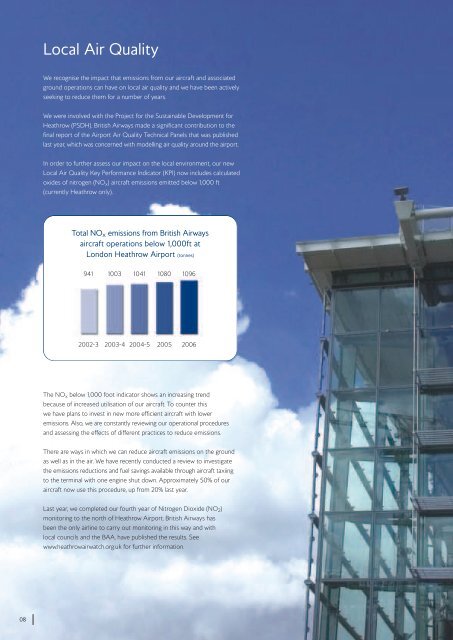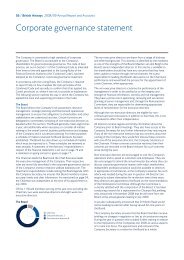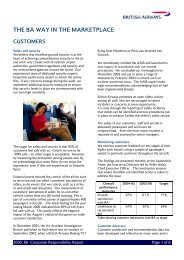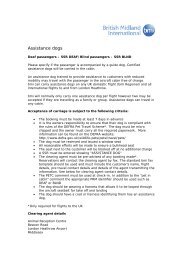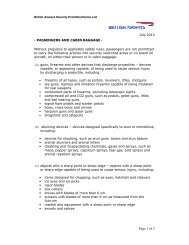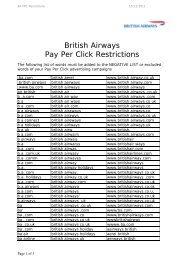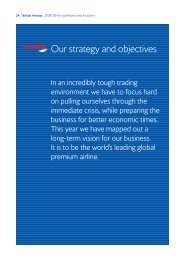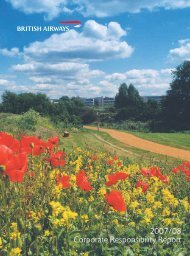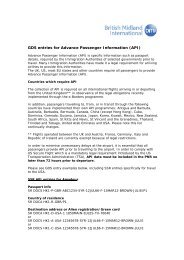Environmental Overview - British Airways
Environmental Overview - British Airways
Environmental Overview - British Airways
You also want an ePaper? Increase the reach of your titles
YUMPU automatically turns print PDFs into web optimized ePapers that Google loves.
Local Air QualityLess waste, more recyclingWe recognise the impact that emissions from our aircraft and associatedground operations can have on local air quality and we have been activelyseeking to reduce them for a number of years.Waste management continues to be a priority area for our environmental programme.The challenge is to manage a complex range of wastes generated by a variety ofbusiness activities.We were involved with the Project for the Sustainable Development forHeathrow (PSDH). <strong>British</strong> <strong>Airways</strong> made a significant contribution to thefinal report of the Airport Air Quality Technical Panels that was publishedlast year, which was concerned with modelling air quality around the airport.In order to further assess our impact on the local environment, our newLocal Air Quality Key Performance Indicator (KPI) now includes calculatedoxides of nitrogen (NO x ) aircraft emissions emitted below 1,000 ft(currently Heathrow only).Our aim is to reduce waste at source, but where this is not possible the priority is tofind ways to re-use it, whether in whole or part. We are committed to recycling anyremaining waste, with an overall goal of reducing our reliance on landfill for finaldisposal. As technology and facilities become available, we will explore the use ofincineration with energy recovery or composting as methods to avoid disposal to landfill.Such efforts are having significant results, with figures showing that the total amountof waste handled by our waste management contractor at Heathrow and Gatwickhas decreased by 9% compared to last year. Overall, there is a 6% improvementyear-on-year in the waste per passenger at Heathrow and Gatwick and we currentlyrecycle 28% of our solid waste at these airports.Total NO x emissions from <strong>British</strong> <strong>Airways</strong>aircraft operations below 1,000ft atLondon Heathrow Airport (tonnes)941 1003 1041 1080 1096Our principal aims of reducing waste at source and recycling all possible unavoidablewaste have resulted in a 10% decrease in the amount of waste going to landfill fromHeathrow and Gatwick in comparison with the previous year. By 2010 we aim to berecycling 50% of our waste and sending none to landfill.To maximise our recycling potential we have also formed a group to focus on therecycling of materials provided as part of the catering product and associated in-flightservice. On top of this, we have recently launched a project to recycle newspapersfrom shorthaul flights arriving into Heathrow.2002-3 2003-4 2004-5 2005 2006Recycling opportunities come in many different guises. For example, we have establisheda new worldwide furniture management contract that promotes the re-use and recyclingof our office furniture, which will help to promote our principal aim of avoiding waste tolandfill. We continue to seek opportunities to source recycled material and have recentlyintroduced recycled paper to all of the office printers in the UK. This allows us to protectthe environment as both a recycler and a purchaser of recycled products.The NO x below 1,000 foot indicator shows an increasing trendbecause of increased utilisation of our aircraft. To counter thiswe have plans to invest in new more efficient aircraft with loweremissions. Also, we are constantly reviewing our operational proceduresand assessing the effects of different practices to reduce emissions.We also recognise water as a precious commodity and we routinely monitor our waterconsumption wherever possible. Through careful consideration we managed to achieve a2.5% reduction on water consumption at our London hub airports of Heathrow and Gatwick.There are ways in which we can reduce aircraft emissions on the groundas well as in the air. We have recently conducted a review to investigatethe emissions reductions and fuel savings available through aircraft taxiingto the terminal with one engine shut down. Approximately 50% of ouraircraft now use this procedure, up from 20% last year.Last year, we completed our fourth year of Nitrogen Dioxide (NO 2 )monitoring to the north of Heathrow Airport. <strong>British</strong> <strong>Airways</strong> hasbeen the only airline to carry out monitoring in this way and withlocal councils and the BAA, have published the results. Seewww.heathrowairwatch.org.uk for further information.Waste Management Methods 2006LHR & LGW TonnesLiquid Treatment 5,895Landfill 4,063Recycled 1,490Liquid Recovery 227Incineration 160N.B. Does not include waste managed bycatering suppliers or airport companies0809


